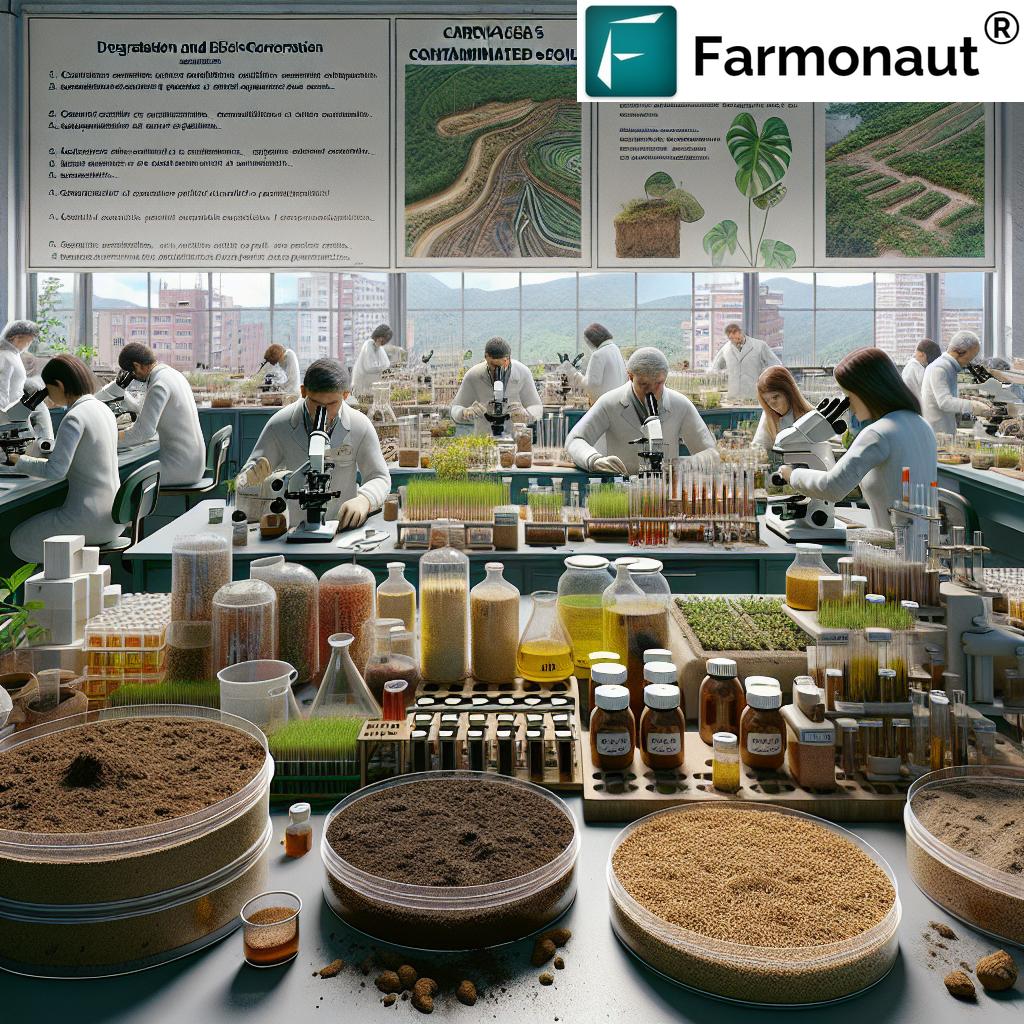Feijoa sellowiana, Feijoa Tree: 7 Powerful Advances for 2026
Table of Contents
- Introduction: Feijoa sellowiana and its Growing Prominence
- Botanical Characteristics & Cultivation
- Agricultural & Economic Importance
- Feijoa sellowiana: 7 Powerful Advances for 2026
- Environmental Benefits & Agroforestry Integration
- Challenges & Future Outlook
- Farmonaut: Enabling Sustainable Feijoa Cultivation
- Comparison Table: Feijoa sellowiana Advances & Sustainability Benefits (2026)
- FAQ: Feijoa sellowiana, Feijoa Tree
“By 2025, global demand for feijoa is projected to rise by 22%, driving advancements in sustainable cultivation methods.”
Introduction: Feijoa sellowiana and its Growing Prominence
Feijoa sellowiana, commonly known as the feijoa tree or pineapple guava, is an evergreen shrub or small tree traditionally native to the highlands of southern Brazil, parts of Colombia, Uruguay, Paraguay, and northern Argentina. Over recent years leading up to 2025, feijoa has gained prominence within the agricultural sector, particularly in temperate to subtropical regions such as New Zealand, Australia, and the Mediterranean.
The fruit’s unique, sweet, aromatic flavor—often described as combining pineapple, guava, and mint notes—makes it increasingly desirable within growing consumer markets seeking exotic fruits. Its remarkable adaptability, resilience to variable climates, and high nutritional value set the stage for exciting innovations in cultivation, processing, and agroforestry that are taking shape by 2026.
This comprehensive guide explores the botanical characteristics of feijoa sellowiana, its rising economic significance, and the seven most powerful technological and sustainable advances projected for 2026. Delve into how adaptability, sustainable practices, and modern research are making feijoa cultivation a standout choice for farmers and businesses, supported by real-world examples and Farmonaut’s satellite technology solutions.
Botanical Characteristics & Cultivation: The Foundation of Feijoa sellowiana
What Makes Feijoa sellowiana Exceptional?
Feijoa sellowiana is an evergreen shrub or small tree that typically reaches heights of 2 to 7 meters. This versatility in size makes it ideal for orchard layouts ranging from intensive commercial groves to mixed-use agroforestry.
- Native Regions: Southern Brazil, Colombia, Uruguay, Paraguay, and Northern Argentina, with increasing adoption in New Zealand, Australia, and the Mediterranean.
- Botanical Features: Thick, leathery leaves with silvery undersides, ornamental white and red flowers.
- Edible Fruits: Egg-sized, green fruits with a soft, aromatic, and sweet pulp prized for fresh consumption as well as processing.
Adaptability Across Diverse Agroecological Zones
Feijoa’s adaptability is one of its greatest strengths:
- Thrives in well-drained soils.
- Prefers mild to moderate climates, but tolerates moderate frost and variable rainfall patterns.
- Demonstrates resistance to drought conditions and some natural pest resistance, requiring relatively low input compared to other crops.
- Flowering occurs in late spring to early summer, yielding showy, waxy white flowers featuring prominent red stamens—a unique asset for pollinator-friendly landscapes.
- Fruits mature in autumn to early winter, with a flavor profile combining pineapple, guava, and mint notes.
This combination of adaptability, resilience, and market value positions feijoa as a leading fruit crop for emerging growers in new regions.
Agricultural & Economic Importance: Feijoa Tree’s Market Momentum
Growing Demand for Exotic and Nutritious Fruits
As of 2025, the rising demand for healthy, exotic fruits has contributed to feijoa’s rapid momentum within the agricultural sector. Feijoa cultivation is particularly gaining ground in New Zealand (the global leader), Australia, and Mediterranean countries such as Italy, Spain, and Greece.
- Feijoa fruits are renowned for their high vitamin C content and antioxidant properties, catching the eye of health-conscious consumers worldwide.
- The fruit’s unique flavor profile and versatile uses (fresh, processed, and fermented) make them a niche item in specialty markets as well as a competitor in mainstream produce sections.
- Owing to their natural pest resistance and relatively low input requirements, feijoa trees are increasingly grown under organic standards, making them a sustainable choice for modern agriculture.
- Feijoa trees contribute to soil conservation, biodiversity, and land resilience when used in agroforestry or mixed farming systems.
The economic importance of feijoa sellowiana rests on its ability to adapt to shifting market and climate realities, offering farmers new income streams and novel market niches, particularly as global interest in exotic fruits continues to accelerate.
For large-scale managers looking to optimize feijoa operations, Farmonaut’s Large Scale Farm Management platform provides real-time satellite monitoring and AI-driven insights, enhancing farm productivity and resource management. This streamlines everything from crop health assessments to irrigation planning for expansive feijoa orchards.
“Feijoa agroforestry increases land productivity by up to 35%, promoting efficient resource use and environmental resilience.”
Feijoa sellowiana: 7 Powerful Advances for 2026
The drive for technological innovation and sustainable agricultural practices will define feijoa sellowiana’s journey into 2026. Here are the seven most influential advances reshaping feijoa cultivation and processing within the next two years:
-
1. Drought-Tolerant and Resilient Cultivars
Ongoing breeding and genetic research are producing new feijoa cultivars that excel in both yield and resilience. These varieties thrive in zones with variable rainfall patterns, withstand mild and moderate frost, and maintain fruit size and quality under water-scarce conditions. Leading research institutes in New Zealand and Australia drive much of this progress.
-
2. Precision Irrigation and Nutrient Management
Integration of satellite-driven precision irrigation systems, including Farmonaut’s AI & satellite technology-powered advisory tools, is helping farmers accurately deliver water and nutrients to feijoa trees. This ensures optimal growth, reduces waste, and improves fruit yield, with environmental benefits from reduced nitrogen runoff and water consumption.
-
3. Advanced Cold Storage & Post-Harvest Processing
By 2025, new advances in cold storage and packaging extend feijoa fruits’ shelf life for up to 6–8 weeks, allowing growers to access expanding global markets far from production zones. Novel processing (e.g., vacuum drying, freezing, and fermentation) transforms feijoa into jams, jellies, juices, desserts, and beverages like feijoa wine and cider, adding new value streams.
-
4. Genetics & Disease-Resistant Varieties
Ongoing genetic mapping and selection programs are resulting in improved disease resistance, particularly against fungal infections and root pathogens. This reduces reliance on chemical pesticides and supports the sustainable, organic credentials of the feijoa crop.
-
5. Blockchain-Based Traceability & Market Access
Cutting-edge blockchain traceability platforms are providing invaluable supply chain transparency for feijoa growers. They allow retailers and consumers to verify the exact origin, methods, and environmental impact of their feijoa fruit, building trust in expanding markets and reducing fraud.
-
6. Environmental & Carbon Footprint Monitoring
Farmonaut’s carbon footprinting solutions help commercial growers track environmental impacts in real time. By accurately measuring the carbon balance of feijoa orchards and processing facilities, stakeholders can receive certification for climate-smart cultivation—increasing market value among eco-conscious consumers.
-
7. Digital Orchard Monitoring & AI-Driven Advisory
Satellite-based and AI-powered crop health platforms (such as Farmonaut) let growers monitor feijoa trees for stress, pest outbreaks, water deficits, and yield prediction. This real-time, data-driven approach is making feijoa cultivation more efficient, sustainable, and profitable.
For growers or agri-entrepreneurs looking for effective fleet and resource management in feijoa orchards, Farmonaut’s Fleet Management portal offers satellite-guided tracking for vehicles, equipment and field activities—helping reduce operational costs and improve resource use efficiency.
Environmental Benefits & Agroforestry Integration: The Sustainable Edge of Feijoa
Feijoa sellowiana stands out as a highly sustainable crop choice as the world faces challenges from climate change, land degradation, and water scarcity. Here’s how feijoa cultivation contributes to environmental resilience and land stewardship:
- Low Input & Natural Pest Resistance: Feijoa trees have inbuilt resilience against many pests, often requiring fewer chemical applications than comparable fruit trees. This property supports organic or low-input agriculture, minimizing contamination of soils and water resources.
- Biodiversity & Habitat Enhancement: The showy flowers of the feijoa tree attract bees, birds, and pollinators. When planted in diversified systems, feijoa helps contribute to on-farm biodiversity, creating ecosystem services for the entire agricultural landscape.
- Soil Conservation & Drought Tolerance: With a robust root system, feijoa trees protect soils from erosion, retain moisture, and stabilize sloped or marginal lands, making them excellent partners in agroforestry or silvopasture systems.
- Climate Resilience: Feijoa’s adaptability to variable rainfall and moderate frost prepares farmers for climate variability—ensuring a reliable harvest season after season.
- Integrated Agroforestry Systems: Studies (including in New Zealand, Uruguay, and Mediterranean parts) show that agroforestry systems with feijoa trees can increase land productivity by up to 35%, enhance pollinator populations, and boost long-term soil health.
Challenges & Future Outlook: Navigating Barriers for Feijoa’s Expansion
Despite its many strengths, feijoa cultivation still faces several challenges as it scales globally:
- Variable Yields and Fruit Size: Different cultivars, shifts in weather, and inconsistent pollination may result in non-uniform fruit sizes and fluctuating yields.
- Sensitivity to Cold: While moderately frost-hardy, extended cold spells can impact flowering and fruit development in some regions.
- Limited Harvest Mechanization: The delicate nature of the fruit (approximately the size of a chicken egg) makes mechanized harvesting challenging, increasing labor requirements and costs.
- Disease Threats: Ongoing research is needed to address fungal pressures and root pathologies in commercial orchards.
However, ongoing research and technological innovation—especially in genetics, automation, and satellite-guided crop monitoring—hold the promise of overcoming these hurdles. As climate adaptation and sustainability become paramount in 2026 and beyond, feijoa’s unique characteristics keep it positioned as a future-ready crop.
Farmonaut: Enabling Sustainable Feijoa Cultivation for 2026 and Beyond
As we look to the future of feijoa sellowiana cultivation, advanced technology and data-driven solutions will be central in optimizing both yield and sustainability. At Farmonaut, we empower growers, enterprises, and governments to make smarter decisions for feijoa orchards by delivering:
- Real-time Satellite Monitoring: Our platform uses multispectral satellite imagery to assess feijoa crop health, soil moisture, and identify stress factors—enabling timely, informed farm interventions.
- AI-Based Advisory: Farmonaut’s Jeevn AI system offers tailored advice on irrigation, fertilization, and pest control, increasing productivity while minimizing inputs.
- Blockchain Traceability: Through our traceability solutions, growers can ensure secure, transparent tracking from orchard to market—vital for accessing premium consumer segments.
- Environmental Impact Tracking: Our carbon footprinting tools guide climate-smart farming, providing metrics supporting eco-labeling and compliance.
- Fleet & Resource Management: We offer comprehensive management tools to track everything from vehicles to water resources in feijoa operations.
- Loan & Insurance Facilitation: Using satellite-verified monitoring, financial institutions can extend loans and insurance to feijoa growers, reducing risk and improving access to capital.
- API Integration: Our API and developer documentation allow seamless integration of geospatial insights into your agri-supply chain and plantation management software.
Comparison Table: Feijoa sellowiana Advances & Sustainability Benefits (2026)
| Advance/Innovation | Description | Estimated Impact on Yield (%) | Estimated Water Use Reduction (%) | Sustainability Benefit | Projected Market Demand (2026) |
|---|---|---|---|---|---|
| Drought-Tolerant Cultivars | New feijoa varieties bred for resilience to drought and variable climates | +20-30% | Up to 40% | Supports farming in marginal/sensitive regions | Very High |
| Precision Irrigation & AI Advisory | Integration of satellite & AI for targeted watering and nutrition | +10-22% | 30-50% | Less resource waste; smarter farm inputs | High |
| Cold Storage/Post-Harvest Processing | Technologies extending shelf life and adding product forms | +15-28% | 15-20% | Reduces spoilage; opens global markets | Very High |
| Disease-Resistant Varieties | Genetic improvements for resistance to common pests/fungi | +12-20% | Indirect | Less chemical use; supports organic farming | High |
| Blockchain Traceability | Digital records for supply chain verification and transparency | N/A | Indirect | Enhances credibility and access to premium markets | Rising |
| Carbon Footprint Monitoring | Satellite-based tracking of orchard carbon output and sequestration | N/A | Indirect | Facilitates certification for climate-smart agriculture | Rising |
| Digital Orchard & AI Crop Monitoring | Remote sensing for real-time crop health, yield, and risk alerts | +8-17% | 20-30% | Optimizes farm management and resources | High |
FAQ: Feijoa sellowiana, Feijoa Tree
-
Q1: What is feijoa sellowiana?
A: Feijoa sellowiana is an evergreen shrub or small tree, native to southern Brazil, Colombia, Uruguay, Paraguay, and northern Argentina. It produces egg-sized, aromatic fruits known for their unique taste—reminiscent of pineapple, guava, and mint. -
Q2: Why is the feijoa tree gaining popularity by 2025-2026?
A: Growing consumer demand for exotic, health-promoting fruits with high vitamin C, antioxidants, and versatile culinary uses has boosted feijoa’s importance. Its adaptability, resilience to drought and frost, and suitability for sustainable and organic agriculture make it appealing globally. -
Q3: What are the biggest advances in feijoa cultivation for 2026?
A: Key advances include drought- and disease-resistant cultivars, precision irrigation, advanced post-harvest processing, cold storage, blockchain traceability, carbon footprint monitoring, and satellite/AI-driven orchard management. -
Q4: How does feijoa cultivation benefit the environment?
A: Feijoa requires low chemical inputs due to its natural pest resistance, supports biodiversity, conserves soil, and increases land productivity in agroforestry systems—making it a climate-resilient and sustainable crop choice. -
Q5: How are satellite technologies relevant for feijoa growers?
A: Satellite imagery and AI help monitor feijoa crop health, optimize inputs, trace supply chains, and reduce operational costs—leading to higher yields, reduced resource wastage, and enhanced sustainability. -
Q6: Can feijoa trees be grown in regions outside South America?
A: Yes. Feijoa thrives in temperate to subtropical climates and is now widely cultivated in New Zealand, Australia, parts of the Mediterranean, and the United States, thanks to its adaptability. -
Q7: What products are made from processed feijoa?
A: Processed feijoa is found in jams, jellies, beverages (juices, ciders, wines), ice creams, desserts, and even essential oils for cosmetics and natural flavorings. -
Q8: How can farmers access Farmonaut’s tech solutions for feijoa?
A: By signing up for Farmonaut’s app or web dashboard, growers can tap into satellite monitoring, AI advice, carbon tracking, and blockchain traceability, among other powerful features. APIs are also available for integration with custom systems. -
Q9: Does feijoa require a lot of water or chemicals?
A: No. Feijoa is drought-tolerant and has natural pest resistance, making it a low-input crop ideal for sustainable, environmentally sensitive farming. -
Q10: What is the market outlook for feijoa after 2026?
A: With innovations in genetics, processing, and sustainability, along with climate adaptation stresses, feijoa’s global demand and market potential are projected to remain strong and continue expanding well beyond 2026.
Conclusion: A Fruit Crop Poised for a Sustainable and Profitable Future
Feijoa sellowiana stands as a symbol of the next generation of resilient, high-value, and eco-friendly fruit crops. From its botanical characteristics and cultural background in the highlands of South America to its momentum in New Zealand, Australia, and emerging Mediterranean regions,feijoa’s trajectory is powered by adaptability, technological innovation, and sustainability.
As challenges in water availability, climate variability, and consumer demands shape the 2026 agricultural landscape, feijoa’s unique traits and ongoing advances in breeding, processing, and digital farm management offer a viable path for farmers and agribusinesses around the globe. With solutions like those offered by Farmonaut, we collectively advance the frontiers of sustainable and profitable feijoa cultivation, ensuring a brighter, healthier, and more diverse future for all stakeholders.














